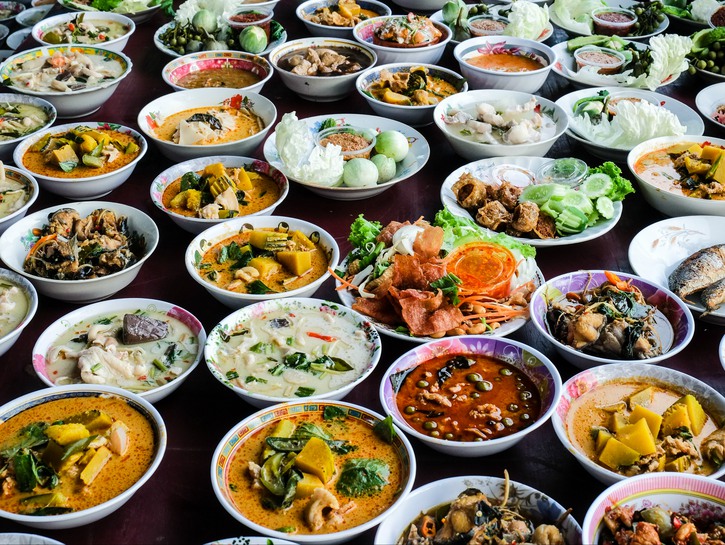
When traveling to tropical Southeast Asia, it will come as no surprise that Thailand is referred to as the “Land of Smiles.” Visitors constantly fall in love with its natural beauty and historic riches, an undeniable truth that caused me to reside in Bangkok for one year; it’s the most visited city in the world with more than 21 million annual guests.
Videos by TravelAwaits
Not only are Thailand’s landscapes breathtaking, but the culture is fascinating, its people overwhelmingly friendly, and its cuisine otherworldly. A spicy edge and aromatic components form the contours of Thai cuisine, and listed below are my top 11 picks for food to try when traveling to Thailand.
Let this be a guide to help you avoid touristy-favored dishes like pad thai and eat like a true local when visiting this unparalleled country.
Of course, the most famous snack, Pad Thai, is a must, but there are so many other dishes. Among my favorite are Pad Krapow (stir-fried vegetables with basil over rice), all the curries made with coconut milk (my favorite is Green Curry, or Gaeng Khiaw Wan), Tom Kha (coconut soup with fresh vegetables), Tom Yum (Spicy Soup), Som Tam (Spicy Green Papaya salad), Kuay Teow (Noodle Soup), and Pad See Ew (Wide Stir-Fried Noodles with vegetables). But maybe best of all is dessert — Mango and Sticky Rice with coconut sauce!
— Barbara Weibel, travel blogger, Hole In The Donut
Soups
1. Tom kha gai
A coconut milk-based soup, tom kha gai is an extremely popular Thai dish that is typically served before the main meal and usually with a side of white rice for dipping. Galangal is the main ingredient that gives tom kha gai its unique flavor, a tropical rhizomatous spice.
This spicy and sour hot soup is teeming with strips of lemongrass, red tomato chunks, oyster mushrooms, chicken breast, kaffir lime leaves, fish sauce and cilantro. Don’t leave Thailand without trying this delicious starter dish!
2. Tom yum goong
Another essential Thai hot soup, tom yum goong is one of the most famous Thai dishes and, in my humble opinion, one of the best soups in the world. Tom yum itself is a type of flavoring used in many Thai dishes, characterized by its hot and sour inflection and the incorporation of many fresh spices and herbs.
Tom yum goong’s main ingredients are fresh shrimp (goong), ginger, kaffir lime leaves, lime juice, fish sauce, sweet white onions, sugar, and crushed chili peppers. Many street-style tom yum soups will be served with nam prik pao, a widely-used Thai chili paste.
Tom yum goong can also be served as a cream-based soup with condensed milk instead of broth, referred to as tom yum goong nam khon.

Tom Yum Goong. Photo Credit: Alexandra Mahoney
Salads
3. Som tam (green papaya salad)
Som tam is Thailand’s only true salad, otherwise referred to as green papaya salad. Food historians believe that som tam actually originated in Thailand’s northeast neighbor nation of Laos, arguably why it is so popular in Thailand’s northern Isaan province. Isaan cuisine may be the spiciest in all of Thailand, so beware when you’re trying som tam salad!
An authentic som tam salad will normally include shredded raw green papaya, dried shrimp, yardlong beans, garlic, peanuts, palm sugar, lime, fish sauce, tomatoes and, of course, lots and lots of red or green chilis. This dish is hot, hot, hot!
Mains
4. Gai pad med mamuang (cashew chicken stir-fry)
If you’re traveling to Thailand, not a huge fan of spicy food and worried about what you’ll eat during your trip, gai pad med mamuang is a great option. A sweet and sour cashew chicken stir-fry, this dish was always one of my go-tos when needing a break from spicy Thai cuisine. Though this is a less-spicy Thai dish, be aware that most Thai food has at least some kick to it.
Gai pad med mamuang is typically made with lightly floured chicken chunks, chopped garlic, yellow onions, dried red chilis, cashew nuts, spring onions, soy sauce, oyster sauce, and a pinch of sugar.
5. Pad see ew
If you’ve ever tried Thai cuisine, you’ve probably heard of pad see ew. Though pad see ew has disputable Chinese origins, Thai culture has adopted the dish and made it their own.
The name pad see ew translates to “fried with soy sauce,” another great option for those seeking a not-so-spicy Thai dish. Pad see ew is prepared with broad flat rice noodles called sen yai, meaning big strip. Other essential ingredients in pad see ew are garlic cloves, broccoli, soy sauce, and sugar.
6. Nam tok
A less popular Thai dish, nam tok was one of my favorite meals whilst living in Thailand and can usually be found solely by street vendors in authentic Thai neighborhoods.
Nam tok literally translates to “beef waterfall” and is another dish originating from Thailand’s Isaan region. Nam tok is made with a generous portion of fatty beef, khao kua, otherwise known as toasted sticky rice powder, fish sauce, a pinch of sugar, cilantro, red onion, mint leaves and, once again, a lot of chili flakes (remember: Isaan cuisine).
7. Pad mama
There are many ways to eat mama style noodles in the Land of Smiles, Thailand’s version of stir-fry ramen noodles. One of the easiest and quickest meals to eat in Thailand, pad mama is a great choice if you’re vegetarian or on-the-go and looking for a quick bite.
A traditional pad mama dish is comprised of a block of mama instant noodles, garlic, eggs, cabbage, carrots, julienned onions, soy sauce, fish sauce and green onion.

Cashew chicken stir fry, or gai pad med mamuang, paired with Thai yellow curry. Photo Credit: Alexandra Mahoney.
Currys
8. Kaeng khiao wan (Thai green curry)
Many countries in Southeast and South Asia have their own versions of curry dishes, and Thailand is no exception. Kaeng khiano wan, or Thai green curry, is a must-try dish when visiting this exotic Southeast Asian country.
The main ingredient in kaeng khiao wan is green curry paste, usually made from cilantro root or cilantro stems and fresh green chilies. Other essential ingredients in an authentic Thai green curry are Thai eggplant, coconut milk, bamboo shoot, kaffir lime leaves, fish sauce, palm sugar, Thai basil leaves, and red chili peppers.
9. Phanaeng curry
Phanaeng curry, also spelled panang curry, is a thick, sweet and salty curry with a nutty peanut flavor. Published in 1890, Mom Somchin Rachanupraphan’s “Tamra Kap Khao” is the world’s first-known mention of phanaeng curry.
Pork phanaeng is the most popular way to consume this Thai curry dish, and its intoxicating flavors stem from Panang red curry paste, typically made with toasted cumin and coriander seeds, white peppercorns, chopped lemongrass and galangal, kaffir lime zest, cilantro roots, chopped shallots, shrimp paste, and ground roasted peanuts.
Other vital ingredients in an authentic Thai phanaeng curry are red and orange bell peppers, onion, Thai basil, and kaffir lime leaves.

A very spicy and authentic Thai green curry from Bangkok. Photo Credit: Alexandra Mahoney
Desserts
10. Khao niaow ma muang (mango sticky rice)
Khao niaow ma muang, or mango sticky rice, is without a doubt Thailand’s number-one dessert menu item. Mango sticky rice can be found practically anywhere in Thailand and is a particularly popular street food snack.
Whatever you do, don’t let the sound of rice and fruit mixed together deter you from trying mango sticky rice. This is a surprisingly unmatched pairing of flavors and textures.
Though this delectable dessert originated in Thailand, it is commonly found throughout other regions of Southeast Asia, including Laos, Cambodia, and Vietnam.
11. Roti
Another popular street food dessert, roti s a wheat-flour pan-fried sweet bread with Muslim origins. Though roti can be found basically anywhere in Thailand, the country’s four southernmost provinces of Satun, Yala, Pattani, and Narathiwat are a popular place to eat roti, since a majority of Thailand’s Muslim population resides in these regions.
Roti is exceedingly similar to Malaysia’s roti canai and India’s flatbread maida paratha. When ordering roti on the street, it is usually offered with various toppings such as sweetened condensed milk, white sugar, banana slices and even chocolate!

Mango sticky rice, or Khao Niaow Ma Muang. Photo Credit: Alexandra Mahoney
We hope we made you hungry for some of Thailand’s culinary delights — and maybe for adventure as well! Happy trails.

